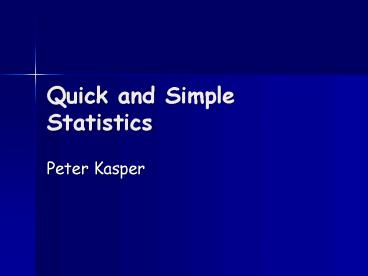Quick and Simple Statistics PowerPoint PPT Presentation
1 / 17
Title: Quick and Simple Statistics
1
Quick and Simple Statistics
- Peter Kasper
2
Basic Concepts
- Variables Distributions
- Mean Standard Deviation
- Estimators Errors
- Comparing Two Sample Results
- Significance
- t-Tests
3
Variables Distributions
- A Variable is anything that can be ..
- Measured (continuous variable)
- E.g. The height of vegetation in an area
- Counted (discreet variable)
- E.g. The number of birds in an area
- Categorized (categorical variable)
- E.g. Birds that are grassland specialists or not
grassland specialists
4
Variables Distributions
- Each variable has a natural distribution i.e.
the frequency at which particular values of the
variable occur - A common example is the Bell Curve
- In general can be arbitrary!
5
Another Bell Curve distribution
A Bell Curve distribution
Different average value and different width
6
Mean Standard Deviation
- The mean of a sample of n measurements of some
variable is defined as .. - µ ?i vi / n
- The standard deviation or width of the
distribution is .. - s 2 ?i (vi - µ )2 / ( n 1 )
7
For a Bell Curve distribution 68 of values are
within 1 s of the mean m 95 of values are within
2 s of the mean m
m
s
s
s
s
8
(No Transcript)
9
Estimators Errors
- The values for µ and s from finite samples vary
even if the samples are part of the same
distribution - They are Estimators of the true values.
- The error on the estimators indicates how much
variation is expected
10
Estimators Errors
- The Standard Error on the mean of a sample of n
measurements is defined as .. - SEµ s / vn
- The error gets smaller as the sample size
increases - µ has a Bell Curve distribution with mean
true mean and SD SEµ
11
Comparing Results
- Assume two different samples
- Are they from the same distribution?
- Compare the two means
- The difference in the means will usually not be
zero - How do we measure the significance of an observed
difference - It will clearly depend on the standard errors
12
Comparing Results
- The standard error on the difference between to
quantities is defined as .. - SEdiff v( SE12 SE22 )
- If the two results are from the same distribution
(Null Hypothesis) - The difference will be a Bell Curve
distribution with mean zero and Standard
Deviation SEdiff
13
Significance
- Can use the difference of the means, ?, and its
error to measure the likelihood of an observed
difference. - What is the probability of randomly getting a
bigger difference than we obtained? - Assuming a Bell Curve
- Probability 32 if ? SE?
- Probability 5 if ? 2 x SE?
14
Significance
- This is NOT the same thing as the probability
that the two distributions are the same. - Probability 1 if ? 0 !
- But it is clearly not impossible to measure the
same mean from two similar but different
distributions
15
t-Tests
- When the size of a sample is small (lt30
measurements), we need to take into account the
uncertainty in the estimates of the Standard
Errors - Instead of comparing ?/SE? with a Normal Bell
curve distribution, Compare a variable t with a
tabulated t-distribution.
16
t-Tests
- The t variable is defined as
- t ? / v( s2/n1 s2/n2 )
- where
- s2 (n1-1)SE12 (n2-1) SE12 / (n1n2-2)
- The number of degrees of freedom (needed by the
tables) are (n1-1) and (n2-1)
17
Conclusion
- This talk has skipped a LOT of details
- It was designed to give you a feel for concepts
- There are lots of resources on the web and in the
library

